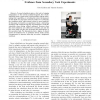Free Online Productivity Tools
i2Speak
i2Symbol
i2OCR
iTex2Img
iWeb2Print
iWeb2Shot
i2Type
iPdf2Split
iPdf2Merge
i2Bopomofo
i2Arabic
i2Style
i2Image
i2PDF
iLatex2Rtf
Sci2ools
ICRA
2010
IEEE
2010
IEEE
Increasing robotic wheelchair safety with collaborative control: Evidence from secondary task experiments
— Powered wheelchairs play a vital role in bringing independence to the severely mobility–impaired. Our robotic wheelchair aims to assist users in driving safely, without undermining their capabilities or curtailing the natural development of their skills. An important research question is to determine the conditions under which shared control is most beneficial. In this paper, we describe an experiment, where a distracting secondary task caused the majority of participants to crash the wheelchair when driving without assistance. However, when they were assisted by our collaborative controller, not only did they drive safely, but they also increased their performance in the secondary task. We demonstrate that a degree of shared control is beneficial even to proficient drivers under certain circumstances, for instance when they are under a heightened workload.
| Added | 26 Jan 2011 |
| Updated | 26 Jan 2011 |
| Type | Journal |
| Year | 2010 |
| Where | ICRA |
| Authors | Tom Carlson, Yiannis Demiris |
Comments (0)

